
'THE GREAT WAR', 'THE WAR TO END WAR', 'WORLD WAR 1'
'What passing-bells for these who die as cattle?
- Only the monstrous anger of the guns.'
from 'Anthem for Doomed Youth'
by Wilfred Owen
1914 - 1918
THE AMBULANCE TRAIN FOR THE CONTINENT
The front cover and picture from a 16 page booklet.
The booklet is illustrated with numerous photos of the interior and carriages
and explains the layout and accommodation.
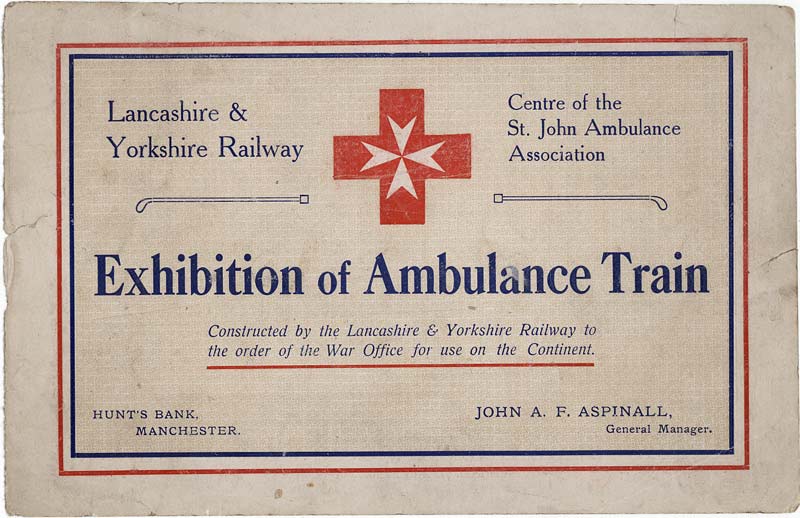
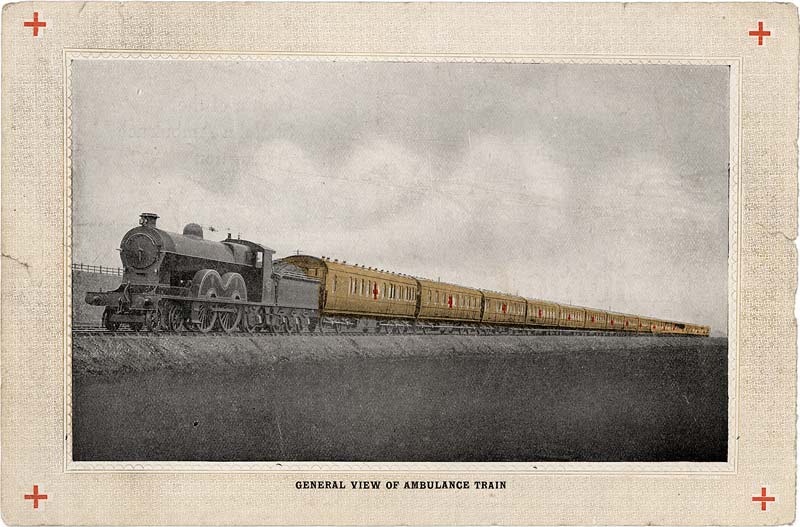
AMBULANCE TRAIN FOR THE CONTINENT
The train has been constructed at the Carriage Works of the Lancashire & Yorkshire Railway and is for use on the Continent in conveying our troops to the Base Hospitals.
The complete train consists of 16 carriages with a total length of 313 yards, and weighing when loaded 492 tons.
The train is vestibuled throughout and fitted with electric light and fans; the exterior is painted khaki with a red cross on both sides of each vehicle.
A good supply of water is carried, the total quantity on the train being 2,733 gallons. Steam heating is provided on all cars, together with the Westinghouse automatic air brake.
|
WARD CAR ARRANGED FOR LYING DOWN PATIENTS
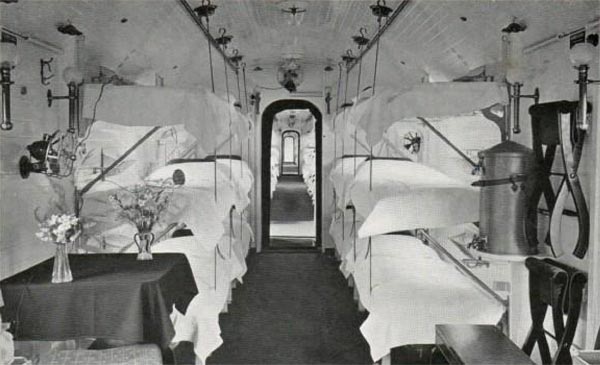
|
WARD CARS
There are ten wards on the train, eight of which are fitted with 38 cots each for lying-down cases, or a total of 288 beds, the other two wards having 18 cots for infectious cases.
The cars are each 56 ft. long and 9 ft. wide, a pair of double doors being arranged on either side near the centre of the cars with ample space inside for the easy manipulation of stretchers.
Each ward car has its interior finished throughout in white enamel, and carries a supply of 156 gallons of water, a six-gallon tank for drinking water being fixed near the centre of each ward.
As will be seen both fixed and portable electric fans are provided, and a small bracket arranged opposite each cot for the portable fans to be used for gassing cases, and one of these can be observed in position.
Two straps are fixed on the outside of each bed to safeguard the patient in transit.
Other interesting features are the numbering of the cots as in ordinary hospitals, camp stools for nurses, and portable stools for lifting the patients into top berths.
|
WARD CAR WITH BOTTOM COTS ARRANGED FOR SITTING-UP PATIENTS
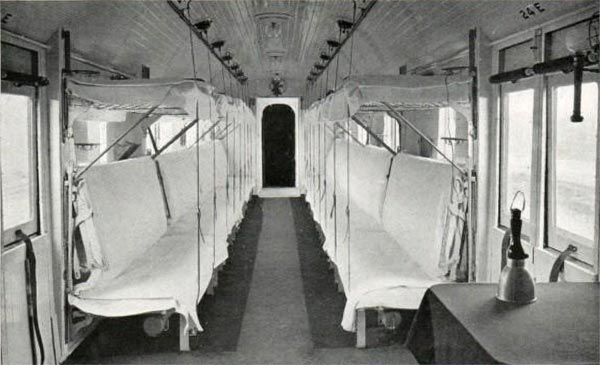
|
WARD CARS (continued)
The cots in all the Ward Cars are arranged in three tiers as compared with two tiers in trains for service in Great Britain.
Owing to the variation in the cases received for transfer to the Hospital Base, the cots have been designed so that the centre tier may be hinged down to form a back to allow of the bottom cots being used as seats, thus doubling the accommodation; at the same time, the top tier of beds may be used for lying-down patients.
It is interesting to note that all the mattresses are filled with wood fibre, and one flock and one feather pillow supplied for each cot.
At the corners of the floor the linoleum is well rounded, and this method is adopted throughout the train for hygiene purposes.
A small table is seen in the front of the picture with a portable electric lamp for the Medical Officers' use.
There is ample ventilation and a large number of air extractors are placed in the roof. Lavatory and cupboard accommodation are provided at the end of each ward car.
|
PHARMACY CAR - PHARMACY
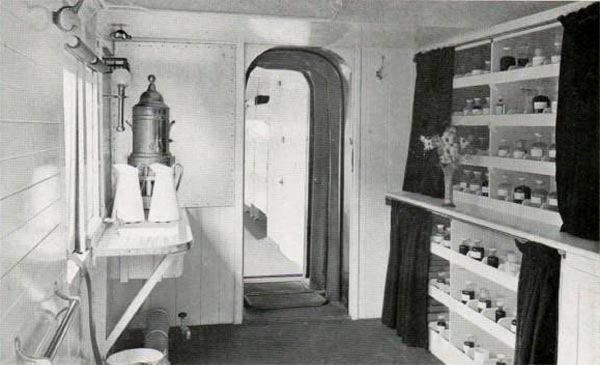
|
PHARMACY CAR
This car is divided into five compartments consisting of the Pharmacy, Treatment Room, Office, Linen Room, and Cupboard for medical comforts.
The Pharmacy, as illustrated, is fitted with cupboards and shelves, a folding table and a hot water heater and sink. It is immediately adjacent to the Treatment Room in which is an operating table, portable electric lamp, and sterilizing tank, the whole of the interior walls being covered with Emdeca Tiling.
The door leading into the Treatment Room has a clear opening of 8 ft. and allows a standard army stretcher to pass through, and one of the special features of the train is that a patient can be carried on a stretcher from any of the eight Ward Cars into the Treatment Room, the minimum gangway being 2 ft. 6 in. wide, or can be carried from the outside of the car direct into the Treatment Room.
The Pharmacy Car has water tanks of 300 gallons capacity.
The Office is provided with a table, chairs, cupboards, safe and other necessary fitments.
|
KITCHEN CARS - KITCHEN
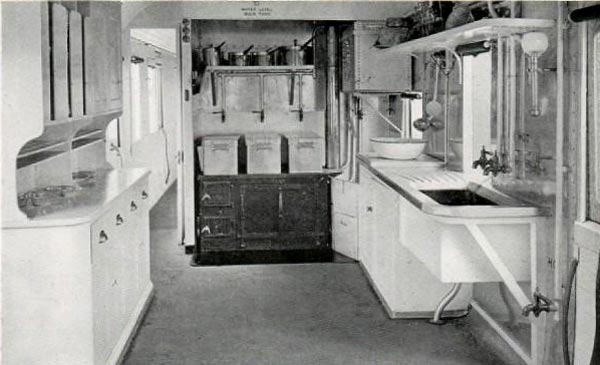
|
KITCHEN CARS
There are two Kitchen Cars on the train, each 54 ft. long and 9 ft. wide, the one containing a Kitchen 18 ft. 1 in. long by 8 ft. 3 in. wide inside, Cooks' Room, Stewards' Room, and Pack Stores, and the other a similar Kitchen and Cooks' Room, together with the Personnel Mess Room and a Stores for Officers' Kits.
The Kitchens are fitted with the French Standard Army Range to burn coal, coke or anthracite, and this range has a copper boiler and hot water installation to keep a constant supply 50 gallons of hot water in a tank, one of which can be seen in the right hand corner of the picture.
On the range are boiling pans recessed into the top plate, and at the back over these pans are water taps for filling purposes. A dresser, washing-up sink, and hot and cold water supplies are also provided.
The water tanks arranged in the roof have a capacity in each of these cars of 300 gallons, and are fitted with gauges, this feature applying to all water tanks throughout the train. Electric light and fans are fitted in the Kitchen, Cooks', Personnel Mess, and Stewrds' Rooms, the latter compartments having the necessary appurtenances. |
STAFF CAR - MEDICAL OFFICERS' MESS
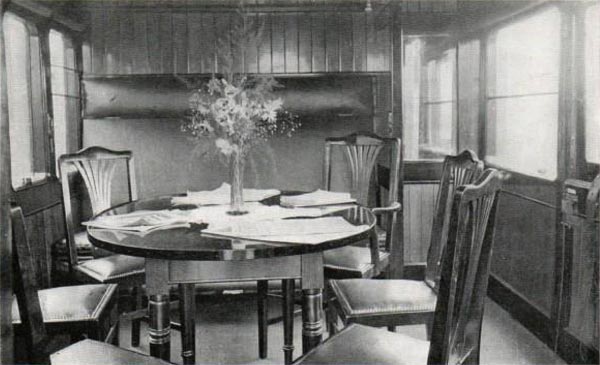
|
STAFF CAR
This car gives accommodation for four Medical Officers and four Nurses, and is provided with Day and sleeping compartments.
The Medical Officers' Mess Room at one end of the car is fitted with a dining table and chairs, together with cupboards and shelves, also an electric fan.
At one end is a Lounge, the back of which, when required, can be hinged to form a berth, it being possible then to make the seat cushion into another berth.
A Mess Room for four nurses is at the other end of the car.
A feature in this vehicle is that, in addition to the ordinary heating apparatus, a self-contained stove and hot water system is fitted to heat the car when standing in sidings on account of the staff living regularly on the train.
|
STAFF CAR - MEDICAL OFFICERS' BERTHS
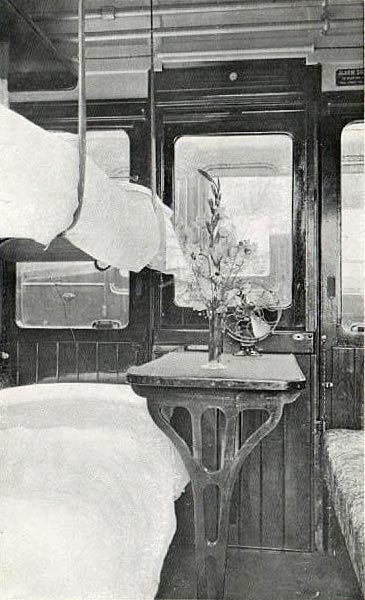
|
STAFF CAR (continued)
There are three compartments with berths for the Medical Officeers immediately adjacent to their Mess Room, entered from a side corridor.
The berths are arranged on one side of each compartment, and the seat portion can be drawn forward to make up a bottom berth only, or the back hinged upward to form two berths as seen in the illustration. The seat on the opposite side of the compartment is of the ordinary type.
Electric fans are provided and each compartment is fitted with a three-way electric lighting switch embracing 'On', 'Off', and 'Dim' positions. A lavatory with a shower spray is arranged at each end of the car.
The remainder of the Personnel have accommodation in a separate car, and the 32 berths provided are of a similar design to those provided for the Medical Officers and a similar self-contained heating apparatus is fitted.

|
THE AMBULANCE TRAIN |
Number of cars |
Accommodation for: |
1 Brake Van with Stores |
1 Train Guard |
1 Kitchen Car |
3 Cooks |
4 Ward Cars |
144 ' Lying down' cases |
1 Pharmacy Car |
-- |
4 Ward Cars |
144 ' Lying down' cases |
| 1 Staff Car |
4 Medical Officers
4 Nurses |
1 Kitchen Car |
3 3 Cooks |
1 Personnel Car |
32 Persons |
1 Car for Infectious Cases |
64 'Sitting Up' Cases
16 'Lying Down' Cases |
1 Brake Van with 2 Infectious Wards |
18 'Lying Down' Cases
1 Train Guard |
Total: 16 cars |
Total: 434 persons |
With the bottom beds in the Ward Cars used for 'sitting up' cases the accommodation was increased to |
Total : 638 persons |
Contributed by : Martin Goodyear
|
RETURN to 'Mixed Bag' Menu
|








